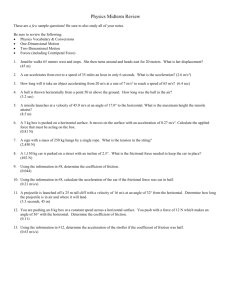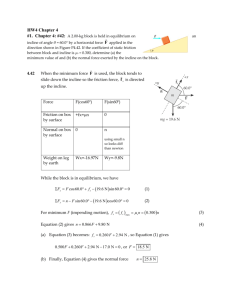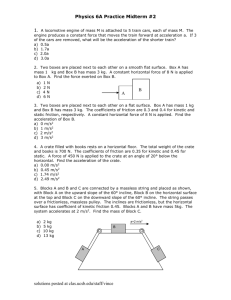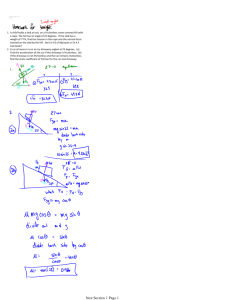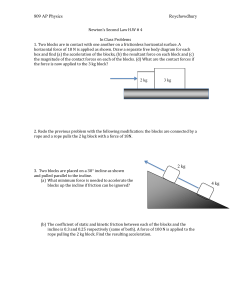Chapter 4 Problems
advertisement
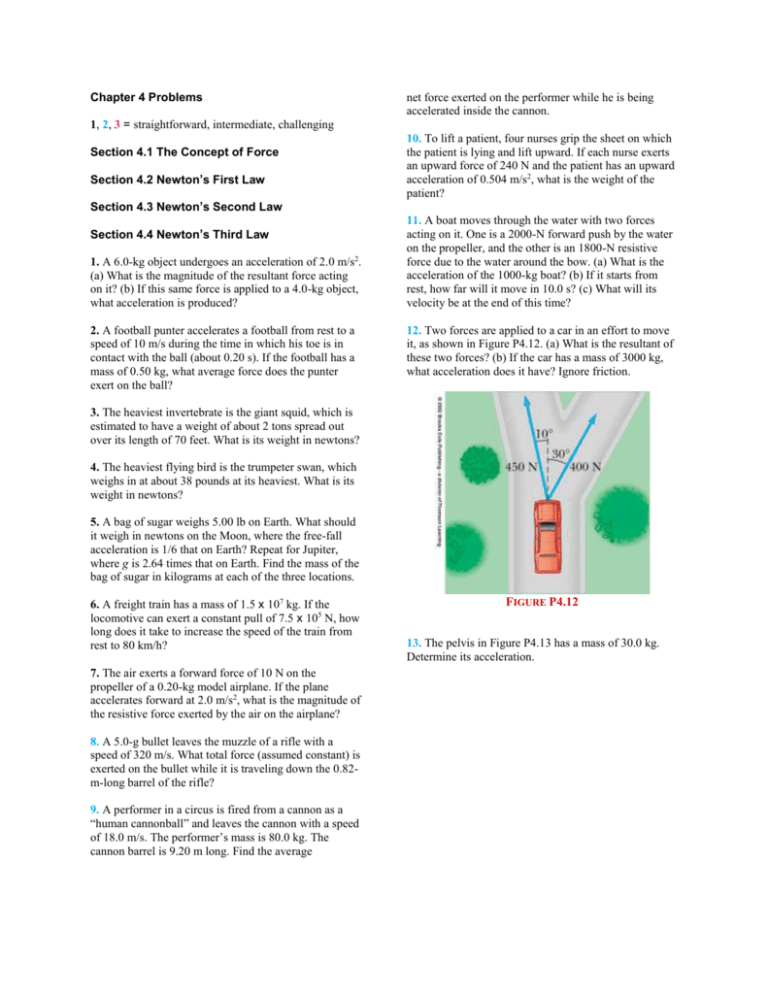
Chapter 4 Problems net force exerted on the performer while he is being accelerated inside the cannon. 1, 2, 3 = straightforward, intermediate, challenging Section 4.1 The Concept of Force Section 4.2 Newton’s First Law 10. To lift a patient, four nurses grip the sheet on which the patient is lying and lift upward. If each nurse exerts an upward force of 240 N and the patient has an upward acceleration of 0.504 m/s2, what is the weight of the patient? Section 4.3 Newton’s Second Law Section 4.4 Newton’s Third Law 1. A 6.0-kg object undergoes an acceleration of 2.0 m/s2. (a) What is the magnitude of the resultant force acting on it? (b) If this same force is applied to a 4.0-kg object, what acceleration is produced? 2. A football punter accelerates a football from rest to a speed of 10 m/s during the time in which his toe is in contact with the ball (about 0.20 s). If the football has a mass of 0.50 kg, what average force does the punter exert on the ball? 11. A boat moves through the water with two forces acting on it. One is a 2000-N forward push by the water on the propeller, and the other is an 1800-N resistive force due to the water around the bow. (a) What is the acceleration of the 1000-kg boat? (b) If it starts from rest, how far will it move in 10.0 s? (c) What will its velocity be at the end of this time? 12. Two forces are applied to a car in an effort to move it, as shown in Figure P4.12. (a) What is the resultant of these two forces? (b) If the car has a mass of 3000 kg, what acceleration does it have? Ignore friction. 3. The heaviest invertebrate is the giant squid, which is estimated to have a weight of about 2 tons spread out over its length of 70 feet. What is its weight in newtons? 4. The heaviest flying bird is the trumpeter swan, which weighs in at about 38 pounds at its heaviest. What is its weight in newtons? 5. A bag of sugar weighs 5.00 lb on Earth. What should it weigh in newtons on the Moon, where the free-fall acceleration is 1/6 that on Earth? Repeat for Jupiter, where g is 2.64 times that on Earth. Find the mass of the bag of sugar in kilograms at each of the three locations. 6. A freight train has a mass of 1.5 x 107 kg. If the locomotive can exert a constant pull of 7.5 x 105 N, how long does it take to increase the speed of the train from rest to 80 km/h? 7. The air exerts a forward force of 10 N on the propeller of a 0.20-kg model airplane. If the plane accelerates forward at 2.0 m/s2, what is the magnitude of the resistive force exerted by the air on the airplane? 8. A 5.0-g bullet leaves the muzzle of a rifle with a speed of 320 m/s. What total force (assumed constant) is exerted on the bullet while it is traveling down the 0.82m-long barrel of the rifle? 9. A performer in a circus is fired from a cannon as a “human cannonball” and leaves the cannon with a speed of 18.0 m/s. The performer’s mass is 80.0 kg. The cannon barrel is 9.20 m long. Find the average FIGURE P4.12 13. The pelvis in Figure P4.13 has a mass of 30.0 kg. Determine its acceleration. 16. Find the tension in the two wires that support the 100-N light fixture in Figure P4.16. FIGURE P4.16 17. A 150-N bird feeder is supported by three cables as shown in Figure P4.17. Find the tension in each cable. FIGURE P4.13 14. The force exerted by the wind on the sails of a sailboat is 390 N north. The water exerts a force of 180 N east. If the boat (including crew) has a mass of 270 kg, what are the magnitude and direction of its acceleration? Section 4.5 Some Applications of Newton’s Laws 15. Find the tension in each cable supporting the 600-N cat burglar in Figure P4.15. FIGURE P4.17 18. The leg and cast in Figure P4.18 weigh 220 N (w1 ). Determine the weight w2 and the angle α needed so that no force is exerted on the hip joint by the leg plus cast. FIGURE P4.18 FIGURE P4.15 19. A person with a broken forearm has the arm in a sling, as in Figure P4.19. The cast and the forearm together weigh 98.0 N. Assuming the upper arm exerts a horizontal force of 24.0 N to the right on the forearm, as shown, determine the force exerted by the sling on the neck. method works. As you construct your explanation, imagine that the children’s parents ask you about your method, that they might make false assumptions about your ability without concrete evidence, and that your explanation is an opportunity to give them confidence in your evaluation technique. (b) Find the string tension if the mass is 132 g and the angle is 46.3°. FIGURE P4.19 20. Two people are pulling a boat through the water as in Figure P4.20. Each exerts a force of 600 N directed at a 30.0° angle relative to the forward motion of the boat. If the boat moves with constant velocity, find the resistive force F exerted by the water on the boat. FIGURE P4.22 23. A 5.0-kg bucket of water is raised from a well by a rope. If the upward acceleration of the bucket is 3.0 m/s2, find the force exerted by the rope on the bucket. 24. A shopper in a supermarket pushes a loaded cart with a horizontal force of 10 N. The cart has a mass of 30 kg. (a) How far will it move in 3.0 s, starting from rest? (Ignore friction.) (b) How far will it move in 3.0 s if the shopper places her 30-N baby in the cart before she begins to push it? FIGURE P4.20 21. The distance between two telephone poles is 50.0 m. When a 1.00-kg bird lands on the telephone wire midway between the poles, the wire sags 0.200 m. Draw a free-body diagram of the bird. How much tension does the bird produce in the wire? Ignore the weight of the wire. 22. You are a judge in a children’s kite-flying contest, and two children will win prizes for the kites that pull most strongly and least strongly on their strings. To measure string tensions, you borrow a weight hanger, some slotted weights, and a protractor from your physics teacher, and use the following protocol, illustrated in Figure P4.22: Wait for a child to get her kite well controlled, hook the hanger onto the kite string about 30 cm from her hand, pile on weight until that section of string is horizontal, record the mass required, and record the angle between the horizontal and the string running up to the kite. (a) Explain how this 25. A 2000-kg car is slowed down uniformly from 20.0 m/s to 5.00 m/s in 4.00 s. (a) What average total force acted on the car during this time, and (b) how far did the car travel during this time? 26. Two packing crates of masses 10.0 kg and 5.00 kg are connected by a light string that passes over a frictionless pulley as in Figure P4.26. The 5.00-kg crate lies on a smooth incline of angle 40.0°. Find the acceleration of the 5.00-kg crate and the tension in the string. FIGURE P4.26 27. Assume that the three blocks in Figure P4.27 move on a frictionless surface and that a 42-N force acts as shown on the 3.0-kg block. Determine (a) the acceleration given this system, (b) the tension in the cord connecting the 3.0-kg and the 1.0-kg blocks, and (c) the force exerted by the 1.0-kg block on the 2.0-kg block. FIGURE P4.31 FIGURE P4.27 32. Determine the magnitude and direction of the force F exerted by the heel of the hand on the forehead in order that the head will exert no force on the neck in Figure P4.32. Disregard the weight of the head and assume it remains at rest. 28. An object of mass 2.0 kg starts from rest and slides down an inclined plane 80 cm long in 0.50 s. What net force is acting on the object along the incline? 29. A 40.0-kg wagon is towed up a hill inclined at 18.5° with respect to the horizontal. The tow rope is parallel to the incline and has a tension of 140 N in it. Assume that the wagon starts from rest at the bottom of the hill, and neglect friction. How fast is the wagon going after moving 80.0 m up the hill? 30. An object with mass m1 = 5.00 kg, resting on a frictionless horizontal table, is connected to a cable that passes over a pulley and then is fastened to a hanging object with mass m2 = 10.0 kg, as in Figure P4.30. Find the acceleration of each object and the tension in the cable. FIGURE P4.32 33. A 1000-kg car is pulling a 300-kg trailer. Together the car and trailer have an acceleration of 2.15 m/s2 in the forward direction. Neglecting frictional forces on the trailer, determine (a) the net force on the car; (b) the net force on the trailer; (c) the force exerted by the trailer on the car; (d) the resultant force exerted by the car on the road. 34. Two objects with masses of 3.00 kg and 5.00 kg are connected by a light string that passes over a frictionless pulley as in Figure P4.34. Determine (a) the tension in the string, (b) the acceleration of each object, and (c) the distance each object will move in the first second of motion if both objects start from rest. FIGURE P4.30 31. The forearm (including the hand) in Figure P4.31 has a mass of 4.26 kg. The upper arm exerts the force shown on the forearm. If the forearm has an acceleration of 2.54 m/s2, determine the mass of the object being pulled by the hand. (Assume the object slides over a frictionless surface.) 38. A hockey puck is hit on a frozen lake and starts moving with a speed of 12.0 m/s. Five seconds later, its speed is 6.00 m/s. (a) What is its average acceleration? (b) What is the average value of the coefficient of kinetic friction between puck and ice? (c) How far does the puck travel during this 5.00-s interval? 39. The coefficient of static friction is 0.800 between the soles of a sprinter’s running shoes and the level track surface on which she is running. Determine the maximum acceleration she can achieve. Do you need to know that her mass is 60.0 kg? FIGURE P4.34 40. A woman at an airport is towing her 20.0-kg suitcase at constant speed by pulling on a strap at an angle of θ above the horizontal (Fig. P4.40). She pulls on the strap with a 35.0-N force, and the friction force on the suitcase is 20.0 N. Draw a free-body diagram of the suitcase. (a) What angle does the strap make with the horizontal? (b) What normal force does the ground exert on the suitcase? Section 4.6 Forces of Friction 35. A dockworker loading crates on a ship finds that a 20-kg crate, initially at rest on a horizontal surface, requires a 75-N horizontal force to set it in motion. However, after the crate is in motion, a horizontal force of 60 N is required to keep it moving with a constant speed. Find the coefficients of static and kinetic friction between crate and floor. 36. In Figure P4.30, m1 = 10 kg and m2 = 4.0 kg. The coefficient of static friction between m1 and the horizontal surface is 0.50 while the coefficient of kinetic friction is 0.30. (a) If the system is released from rest, what will its acceleration be? (b) If the system is set in motion with m2 moving downward, what will be the acceleration of the system? 37. A 1000-N crate is being pushed across a level floor at a constant speed by a force F of 300 N at an angle of 20.0° below the horizontal as shown in Figure P4.37a. (a) What is the coefficient of kinetic friction between the crate and the floor? (b) If the 300-N force is instead pulling the block at an angle of 20.0° above the horizontal as shown in Figure P4.37b, what will be the acceleration of the crate? Assume that the coefficient of friction is the same as found in (a). FIGURE P4.37 FIGURE P4.40 41. The coefficient of static friction between the 3.00-kg crate and the 35.0° incline of Figure P4.41 is 0.300. What mini-mum force F must be applied to the crate perpendicular to the incline to prevent the crate from sliding down the incline? FIGURE P4.41 42. A box of books weighing 300 N is shoved across the floor of an apartment by a force of 400 N exerted downward at an angle of 35.2° below the horizontal. If the coefficient of kinetic friction between box and floor is 0.570, how long does it take to move the box 4.00 m, starting from rest? 43. An object falling under the pull of gravity experiences a frictional force of air resistance. The magnitude of this force is approximately proportional to the speed of the object, f = bv. Assume that b = 15 kg/s and m = 50 kg. (a) What is the terminal speed that the object reaches while falling? (b) Does your answer to part (a) depend on the initial speed of the object? Explain. 44. A student decides to move a box of books into her dormitory room by pulling on a rope attached to the box. She pulls with a force of 80.0 N at an angle of 25.0° above the horizontal. The box has a mass of 25.0 kg, and the coefficient of kinetic friction between box and floor is 0.300. (a) Find the acceleration of the box. (b) The student now starts moving the box up a 10.0° incline, keeping her 80.0-N force directed at 25.0° above the line of the incline. If the coefficient of friction is unchanged, what is the new acceleration of the box? 45. Objects with masses m1 = 10.0 kg and m2 = 5.00 kg are connected by a light string that passes over a frictionless pulley as in Figure P4.30. If, when the system starts from rest, m2 falls 1.00 m in 1.20 s, determine the coefficient of kinetic friction between m1 and the table. 46. A car is traveling at 50.0 km/h on a flat highway. (a) If the coefficient of friction between road and tires on a rainy day is 0.100, what is the minimum distance in which the car will stop? (b) What is the stopping distance when the surface is dry and the coefficient of friction is 0.600? 47. A 2.00-kg block is given an initial speed of 2.50 m/s up a plane inclined 15.0° with the horizontal. The coefficient of kinetic friction between block and plane is 0.250. What speed does it have just as it returns to its initial position? kinetic friction between the 7.00-kg object and the plane is 0.250. FIGURE P4.49 50. A 2.00-kg block is held in equilibrium on an incline of angle θ 60.0° by a horizontal force F applied in the direction shown in Figure P4.50. If the coefficient of static friction between block and incline is μs = 0.300, determine (a) the minimum value of F and (b) the normal force of the incline on the block. FIGURE P4.50 51. The person in Figure P4.51 weighs 170 lb. The crutches each make an angle of 22.0° with the vertical (as seen from the front). Half of his weight is supported by the crutches. The other half is supported by the vertical forces exerted by the ground on his feet. Assuming he is at rest and the force exerted by the ground on the crutches acts along the crutches, determine (a) the smallest possible coefficient of friction between crutches and ground and (b) the magnitude of the compression force supported by each crutch. 48. The driver of a 600-kg sports car, heading directly for a railroad crossing 250 m away, applies the brakes in a panic stop. The car is moving (illegally) at 40 m/s, and the brakes can supply a friction force of 1200 N. (a) How fast is the car moving when it reaches the crossing? (b) Will the driver escape collision with a freight train that is 80.0 m away from the intersection and traveling at 23 m/s? 49. Find the acceleration experienced by each of the two objects shown in Figure P4.49 if the coefficient of FIGURE P4.51 52. A small block of mass m = 2.00 kg rests on the left edge of a block of length L = 3.00 m and mass M = 8.00 kg. The coefficient of kinetic friction between the two blocks is μk = 0.300, and the surface on which the 8.00kg block rests is frictionless. A constant horizontal force of magnitude F = 10.0 N is applied to the 2.00-kg block, setting it in motion as shown in Figure P4.52a. (a) How long will it take before this block makes it to the right side of the 8.00-kg block, as shown in Figure P4.52b? (Note: Both blocks are set in motion when F is applied.) (b) How far does the 8.00-kg block move in the process? FIGURE P4.55 56. As a protest against the umpire’s calls, a baseball pitcher throws a ball straight up into the air at a speed of 20.0 m/s. In the process, he moves his hand through a distance of 1.50 m. If the ball has a mass of 0.150 kg, find the force he exerts on the ball to give it this upward speed. FIGURE P4.52 Additional Problems 53. Find the net force exerted by the cables on the leg in Fig. P4.53. The cables are horizontal before passing over the pulleys. Assume the leg remains at rest. 57. A girl coasts down a hill on a sled, reaching a level surface at the bottom with a speed of 7.0 m/s. If the coefficient of friction between runners and snow is 0.050 and the girl and sled together weigh 600 N, how far does the sled travel on the level surface before coming to rest? 58. (a) What is the minimum force of friction required to hold the system of Figure P4.58 in equilibrium? (b) What coefficient of static friction between the 100-N block and the table ensures equilibrium? (c) If the coefficient of kinetic friction between the 100-N block and the table is 0.250, what hanging weight should replace the 50.0-N weight to allow the system to move at a constant speed once it is set in motion? FIGURE P4.53 54. One of the great dangers to mountain climbers is an avalanche, in which a large mass of snow and ice breaks loose and goes on an essentially frictionless ride down a mountainside on a cushion of compressed air. If you were on a 30.0° mountain slope and an avalanche started 400 m up the slope, how much time would you have to get out of the way? 55. (a) What is the resultant force exerted by the two cables supporting the traffic light in Figure P4.55? (b) What is the weight of the light? FIGURE P4.58 59. A box rests on the back of a truck. The coefficient of static friction between box and truck bed is 0.300. (a) When the truck accelerates forward, what force accelerates the box? (b) Find the maximum acceleration the truck can have before the box slides. 60. A 4.00-kg block is pushed along the ceiling with a constant applied force of 85.0 N that acts at an angle of 55.0° with the horizontal, as in Figure P4.60. The block accelerates to the right at 6.00 m/s2. Determine the coefficient of kinetic friction between block and ceiling. Find (a) the acceleration of the block, (b) the coefficient of kinetic friction between it and the incline, (c) the frictional force acting on the block, and (d) the speed of the block after it has slid 2.00 m. 64. A 5.0-kg penguin sits on a 10-kg sled, as in Figure P4.64. A horizontal force of 45 N is applied to the sled, but the penguin attempts to impede the motion by holding onto a cord attached to a wall. The coefficient of kinetic friction between the sled and snow as well as that between the sled and the penguin is 0.20. (a) Draw a free-body diagram for the penguin and one for the sled, and identify the reaction force for each force you include. Determine (b) the tension in the cord and, (c) the acceleration of the sled. FIGURE P4.60 61. A frictionless plane is 10.0 m long and inclined at 35.0°. A sled starts at the bottom with an initial speed of 5.00 m/s up the incline. When it reaches the point at which it momentarily stops, a second sled is released from the top of this incline with an initial speed vi. Both sleds reach the bottom of the incline at the same moment. (a) Determine the distance that the first sled traveled up the incline. (b) Determine the initial speed of the second sled. 62. Three objects are connected by light strings as shown in Figure P4.62. The string connecting the 4.00kg object and the 5.00-kg object passes over a light frictionless pulley. Determine (a) the acceleration of each object and (b) the tension in the two strings. FIGURE P4.64 65. Two boxes of fruit on a frictionless horizontal surface are connected by a light string as in Figure P4.65, where m1 = 10 kg and m2 = 20 kg. A force of 50 N is applied to the 20-kg box. (a) Determine the acceleration of each box and the tension in the string. (b) Repeat the problem for the case where a coefficient of kinetic friction between each box and the surface is 0.10. FIGURE P4.65 66. A high diver of mass 70.0 kg jumps off a board 10.0 m above the water. If his downward motion is stopped 2.00 s after he enters the water, what average upward force did the water exert on him? FIGURE P4.62 63. A 3.00-kg block starts from rest at the top of a 30.0° incline and slides 2.00 m down the incline in 1.50 s. 67. Two people pull as hard as they can on ropes attached to a 200-kg boat. If they pull in the same direction, the boat has an acceleration of 1.52 m/s 2 to the right. If they pull in opposite directions, the boat has an acceleration of 0.518 m/s2 to the left. What is the force exerted by each person on the boat? (Disregard any other forces on the boat.) 68. A 3.0-kg object hangs at one end of a rope that is attached to a support on a railroad car. When the car accelerates to the right, the rope makes an angle of 4.0° with the vertical, as shown in Figure P4.68. Find the acceleration of the car. perpendicular to the ceiling. Determine (a) the angle θ and (b) the tension in the string. FIGURE P4.71 FIGURE P4.68 69. The three blocks of masses 10.0 kg, 5.00 kg, and 3.00 kg are connected by light strings that pass over frictionless pulleys as shown in Figure P4.69. The acceleration of the 5.00-kg block is 2.00 m/s2 to the left, and the surfaces are rough. Find (a) the tension in each string and (b) the coefficient of kinetic friction between blocks and surfaces. (Assume the same μk for both blocks in contact with surfaces.) FIGURE P4.69 70. An inquisitive physics student, wishing to combine pleasure with scientific inquiry, rides on a roller coaster sitting on a bathroom scale. (Do not try this yourself on a roller coaster that forbids loose heavy packages.) The bottom of the seat in the roller coaster car is in a plane parallel to the track. The seat has a perpendicular back and a seat belt that fits around the student’s chest in a plane parallel to the bottom of the seat. The student lifts his feet from the floor, so that the scale reads his weight, 200 lb, when the car is horizontal. At one point during the ride, the car zooms with negligible friction down a straight slope inclined at 30.0° below the horizontal. What does the scale read there? 71. A van accelerates down a hill (Fig. P4.71), going from rest to 30.0 m/s in 6.00 s. During the acceleration, a toy (m = 0.100 kg) hangs by a string from the van’s ceiling. The acceleration is such that the string remains 72. An 80-kg stuntman jumps from the top of a building 30 m above a catching net. Assuming that air resistance exerts a 100-N force on the stuntman as he falls, determine his velocity just before he hits the net. 73. The parachute on a race car of weight 8800 N opens at the end of a quarter-mile run when the car is traveling at 35 m/s. What total retarding force must be supplied by the parachute to stop the car in a distance of 1000 m? 74. On takeoff, the combined action of the air around the engines and wings of an airplane exerts an 8000-N force on the plane, directed upward at an angle of 65.0° above the horizontal. The plane rises with constant velocity in the vertical direction while continuing to accelerate in the horizontal direction. (a) What is the weight of the plane? (b) What is its horizontal acceleration? 75. A 72-kg man stands on a spring scale in an elevator. Starting from rest, the elevator ascends, attaining its maximum speed of 1.2 m/s in 0.80 s. It travels with this constant 76. A sled weighing 60.0 N is pulled horizontally across snow so that the coefficient of kinetic friction between sled and snow is 0.100. A penguin weighing 70.0 N rides on the sled, as in Fig. P4.76. If the coefficient of static friction between penguin and sled is 0.700, find the maximum horizontal force that can be exerted on the sled before the penguin begins to slide off. Chris’s true weight is 320 N, and the chair weighs 160 N. (a) Show that the acceleration of the system is upward and find its magnitude. (b) Find the force Chris exerts on the chair. FIGURE P4.76 77. The board sandwiched between two other boards in Figure P4.77 weighs 95.5 N. If the coefficient of friction between the boards is 0.663, what must be the magnitude of the compression forces (assume horizontal) acting on both sides of the center board to keep it from slipping? FIGURE P4.79 FIGURE P4.77 78. Determine the magnitude of the net force exerted by the cable on the leg in Figure P4.78. FIGURE P4.78 79. An inventive child named Chris wants to reach an apple in a tree without climbing the tree. Sitting in a chair connected to a rope that passes over a frictionless pulley (Fig. P4.79), Chris pulls on the loose end of the rope with such a force that the spring scale reads 250 N. 80. A fire helicopter carries a 620-kg bucket of water at the end of a 20.0-m long cable. When the helicopter is flying back from a fire at a constant speed of 40.0 m/s, the cable makes an angle of 40.0° with respect to the vertical. Deter-mine the force exerted by air resistance on the bucket.
